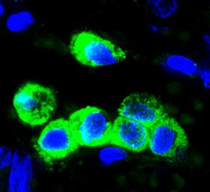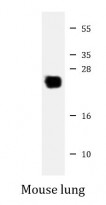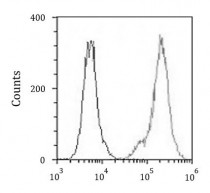ARG59531
anti-SFTPC / SP-C antibody
anti-SFTPC / SP-C antibody for Flow cytometry,ICC/IF,Western blot and Human,Mouse,Rat
Overview
| Product Description | Rabbit Polyclonal antibody recognizes SFTPC / SP-C |
|---|---|
| Tested Reactivity | Hu, Ms, Rat |
| Predict Reactivity | Bov |
| Tested Application | FACS, ICC/IF, WB |
| Host | Rabbit |
| Clonality | Polyclonal |
| Isotype | IgG |
| Target Name | SFTPC / SP-C |
| Antigen Species | Human |
| Immunogen | KLH-conjugated synthetic peptide corresponding to aa. 1-30 (N-terminus) of Human SFTPC / SP-C. |
| Conjugation | Un-conjugated |
| Alternate Names | BRICD6; SP-C; Val; SFTP2; SP5; PSP-C; Pulmonary surfactant-associated protein C; Pulmonary surfactant-associated proteolipid SPL; SMDP2 |
Application Instructions
| Application Suggestion |
|
||||||||
|---|---|---|---|---|---|---|---|---|---|
| Application Note | * The dilutions indicate recommended starting dilutions and the optimal dilutions or concentrations should be determined by the scientist. | ||||||||
| Positive Control | Mouse lung |
Properties
| Form | Liquid |
|---|---|
| Purification | Purification with Protein A and immunogen peptide. |
| Buffer | PBS and 0.09% (W/V) Sodium azide. |
| Preservative | 0.09% (W/V) Sodium azide. |
| Storage Instruction | For continuous use, store undiluted antibody at 2-8°C for up to a week. For long-term storage, aliquot and store at -20°C or below. Storage in frost free freezers is not recommended. Avoid repeated freeze/thaw cycles. Suggest spin the vial prior to opening. The antibody solution should be gently mixed before use. |
| Note | For laboratory research only, not for drug, diagnostic or other use. |
Bioinformation
| Database Links |
Swiss-port # P11685 Rat Pulmonary surfactant-associated protein C Swiss-port # P11686 Human Pulmonary surfactant-associated protein C |
|---|---|
| Gene Symbol | SFTPC |
| Gene Full Name | surfactant protein C |
| Background | This gene encodes the pulmonary-associated surfactant protein C (SPC), an extremely hydrophobic surfactant protein essential for lung function and homeostasis after birth. Pulmonary surfactant is a surface-active lipoprotein complex composed of 90% lipids and 10% proteins which include plasma proteins and apolipoproteins SPA, SPB, SPC and SPD. The surfactant is secreted by the alveolar cells of the lung and maintains the stability of pulmonary tissue by reducing the surface tension of fluids that coat the lung. Multiple mutations in this gene have been identified, which cause pulmonary surfactant metabolism dysfunction type 2, also called pulmonary alveolar proteinosis due to surfactant protein C deficiency, and are associated with interstitial lung disease in older infants, children, and adults. Alternatively spliced transcript variants encoding different protein isoforms have been identified.[provided by RefSeq, Feb 2010] |
| Function | Pulmonary surfactant associated proteins promote alveolar stability by lowering the surface tension at the air-liquid interface in the peripheral air spaces. [UniProt] |
| Cellular Localization | Secreted, extracellular space, surface film. [UniProt] |
| Calculated MW | 21 kDa |
Images (3) Click the Picture to Zoom In
-
ARG59531 anti-SFTPC / SP-C antibody ICC/IF image
Immunofluorescence: Human lung cells stained with ARG59531 anti-SFTPC / SP-C antibody (green) at 1:25 dilution. DAPI was used to stain the cell nuclear (blue).
-
ARG59531 anti-SFTPC / SP-C antibody WB image
Western blot: 20 µg of Mouse lung lysate stained with ARG59531 anti-SFTPC / SP-C antibody at 1:2000 dilution.
-
ARG59531 anti-SFTPC / SP-C antibody FACS image
Flow Cytometry: A549 cells were fixed with 2% paraformaldehyde (10 min) and then permeabilized with 90% methanol for 10 min. The cells were then incubated in 2% BSA to block non-specific protein-protein interactions and stained with ARG59531 anti-SFTPC / SP-C antibody (right histogram) at 1:25 dilution for 60 min at 37°C, followed by DyLight®488 labelled secondary antibody. Isotype control antibody (left histogram) was Rabbit IgG1 (1 µg/10^6 cells) used under the same conditions. Acquisition of > 10000 events was performed.








